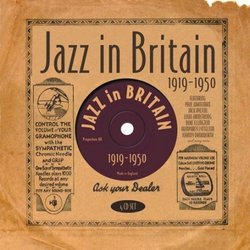Somewhat Lacking as a Package
Barry McCanna | Normandy, France | 07/15/2007
(3 out of 5 stars)
"This set is a tie-in; that's to say, its release coincided with the republication of Jim Godbolt's 1984 book. The author assembled this compilation to follow the hardback narrative, and also produced the accompanying 64-page package, so it warrants serious consideration. To deal first with the merits, the discs are in slip-cases, which reduce the overall bulk, and the box carries a convincing reproduction of a 78 sleeve. Transfers are clean and for the most part fresh-sounding, with the exception of the first (ODJB) track, which seems suppressed compared with my vinyl version. Perhaps most importantly for a collector is that the Devonshire Dance Band recording of "Sugar Foot Stomp" is an alternate take, which was not thought previously to exist (a fact which has not been picked in the notes).
It is acknowledged that there are omissions, which begs the question why that was not overcome by the simple expedient of allocating only one track to a particular band, thus enabling the net to be cast wider. As it is, there is nothing of the Piccadilly Hotel bands, nor of those other American influences Roy Fox, Carroll Gibbons and Jack Harris, all of whom led resident hotel bands. The BBC dance bands also are conspicuous by their absence, despite Jack Payne's command of the jazz idiom and Henry Hall's use of Benny Carter as staff arranger (mentioned in passing as improbable!), to say nothing of the enormous listening audiences which they attracted.
Furthermore, Jim Godbolt's treatment of the subject (which presumably echoes his book) is something of a disappointment. It behoves a historian to get his facts right, yet the notes contain a number of elementary mistakes. For example, what he calls Elizalde's Savoy recordings were made for the Brunswick not the Decca label,; Al Starita directed Jack Hylton's Kit-Cat (not Kit-Kat) Band, and in the thirties Jack Jackson was resident at the Dorchester, not the Grosvenor (House) Hotel, which was Sydney Lipton's domain.
To compound the felony, dubious assertions and sweeping generalisations abound. So, for example, we are reliably informed that Paul Whiteman was hardly entitled to wear the crown of "The King Of Jazz" (which may be true, but the point needs to be substantiated) and that Ambrose was a mediocre violinist (which I doubt, and in any case does not invalidate his place as leader of one of the best dance bands on either side of the Atlantic).
Indeed, it is the dance band leaders who are cast as the villains of the piece. We are told that dance band musicians worked in "a milieu of cloying and corny arrangements and some ghastly period vocals" and had to "prevail upon their frock-coated (sic), baton-waving, forever-beaming band leaders to be allowed the occasional chorus and special arrangement of a jazz standard". Jack Hylton is singled out as having "had in his ranks a jazz pressure group", which is a prime example of how to confuse cause and effect!
This seems a very questionable approach. The fact is that it was the night club owners who urged restraint (which could be cast aside for live broadcasts by the BBC), and the record companies, both here and in America, which dictated the type of music that bands could commit to wax.
The "visiting firemen" are well represented here, from the 1919 visit of the ODJB onwards. Yet despite the enthusiasm which greeted them, reference is made to "the forties when the music was really taking hold in this country". This is attributed to "the outbreak of war", which saw "considerable changes in public taste" and "led to jazz becoming more acceptable to the general public. These changes were noted by opportunistic band leaders..."
There is more in the same vein, but that should suffice to give the flavour of it. This may be history, but not as it should be practised academically. I've devoted more time to the accompanying text because the subject is one which merits serious attention (Parlophone led with a series of LPs entitled "Jazz In Britain"), but the way in which this compilation has been annotated does it a disservice.
If that (rather large) caveat is borne in mind the set can be recommended provided also that your taste is sufficiently catholic to embrace the variety of styles on offer.
"
Jazz in Britian
Thomas R. Ciesla | inland empire, So. Calif | 10/14/2005
(4 out of 5 stars)
"The work of these early jazz musicians shows they really got into the pace of the jazz era. Jazz music was a very exportsble product and was taken up in Europe with warmth and welcome. It did add spice to the scene, after the somewhat drab music of the early teen years. Real gusto was the order of the day in Berlin. My favorite jazz era was the period 1928 thru 1932. Jazz in Britian goes as far as 1950. Way to modern for me. But did enjoy Fats Waller, excellent piano man."


 Track Listings (26) - Disc #1
Track Listings (26) - Disc #1